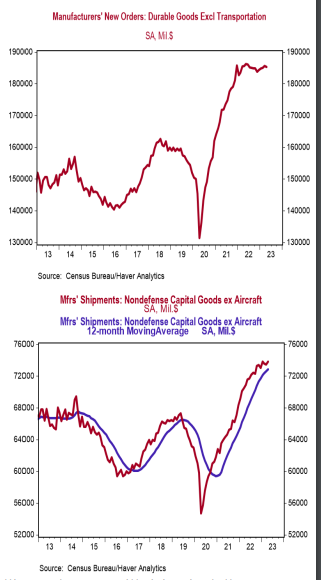- New orders for durable goods rose 1.1% in April (+1.6% including revisions to prior months), easily beating the consensus expected decline of 1.0%. Orders excluding transportation declined 0.2% in April (-0.1% including revisions), versus a consensus expected -0.1%. Orders are up 4.2% from a year ago, while orders excluding transportation are down 0.2%.
- A rise in orders for defense aircraft and machinery in April offset declines across nearly all other major categories.
- The government calculates business investment for GDP purposes by using shipments of non-defense capital goods excluding aircraft. That measure rose 0.5% in April. If unchanged in May and June, these orders would be up at a 1.2% annualized rate in Q2 versus the Q1 average.
- Unfilled orders rose 0.8% in April and are up 5.2% in the past year.
Implications:
New orders for durable goods rose 1.1% in April, easily beating the consensus expectation for a decline. However, when you look past the headline, there isn’t a whole lot to like in the April report. The increase in orders was due to the typically volatile defense aircraft category, which jumped 5.5% in April after declines over the prior two months. Stripping out transportation, orders slipped 0.2% in April with declines across most major categories. Diving into the details shows that a 1.0% rise in machinery orders was more than offset by declines in computer and electronic products (-1.4%), electrical equipment (-1.0%), and primary metals (-0.5%), while fabricated metal product orders showed no change. One piece of positive news in today’s report was that core shipments – a key input for business investment in the calculation of GDP – rose 0.5% in April and, if unchanged in May and June, would be up at a 1.2% annualized rate in the second quarter versus the Q1 average. While still positive in Q2, that would be the fifth consecutive quarterly deceleration in the pace of growth, and would represent the weakest quarter since the shutdown-restricted second quarter of 2020. In the past year, orders for durable goods are up 4.2%, while orders excluding transportation are down 0.2%. But when you consider that producer prices for capital equipment are up 5.5% in the past year, it means that while headline orders are still rising in dollar terms, they are declining when adjusted for inflation. A number of factors are likely to generate turbulent footing as we continue further into 2023: a tighter Federal Reserve, the tightening of lending standards following stress in the banking sector, and withdrawal symptoms following the COVID-era economic morphine that artificially boosted both consumer and business spending. In addition, the return toward services means a large portion of goods-related activity will soften in the year ahead, even as some durables that facilitate services recover. While the data to-date suggests the economy is still growing modestly in the second quarter, we believe a recession awaits us later this year or early in 2024. In recent news on the housing front, pending home sales, which are contracts on existing homes, were unchanged in April after a 5.2% decline in March. Plugging these figures into our model suggests existing homes will be roughly flat in May.





